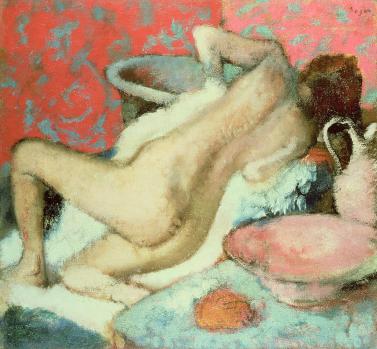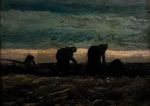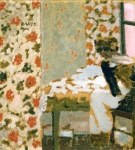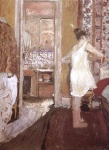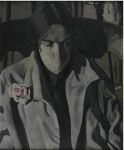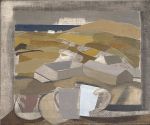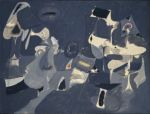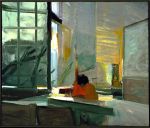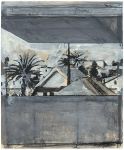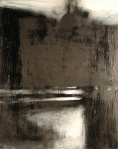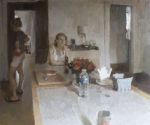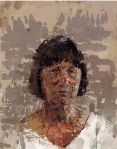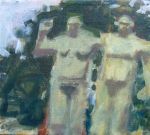Landing a Plane in High Winds: Painting and Photography
March 6, 2019 § Leave a comment
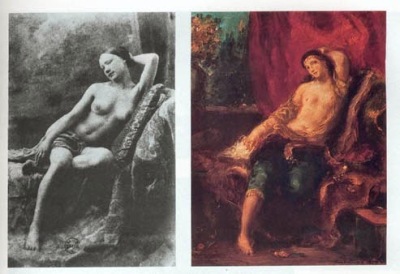 Eugene Delacroix
Eugene Delacroix
“From today, painting is dead.” (Paul Delaroche after the invention of the daguerreotype in 1839.)
“How difficult it is to learn not to see like cameras…the camera sees everything at once. We don’t.” -David Hockney
Photography and painting have long contended over a common territory, the faithful representation of reality. Ever since Leonardo da Vinci declared that the highest objective of painting was to create convincing illusions of volume, light and depth on the flat picture surface artists have sought that ideal through assiduous study, visual acuity and manual skill. This centuries old assumption regarding the goal of painting led people to declare the death of painting when the first photographic process emerged in the early 1800s.The camera, with the press of a button, achieved effortlessly what once took an artist years to perfect.
Early 19th century photographers struggled to distinguish themselves from the mere button-pushers by finding the Art in these new processes. They did this largely by imitating painting, in a sense appropriating the language of image making that centuries of painters in the west had established. Painters, on the other hand, were quick to use the new medium as an assist in painting. Delacroix is an early example, as is Degas, who left thousands of photographs in his studio at his death in 1927. In these documents we recognize the models for some of his best known paintings. Bonnard and Vuillard also left photographs of their models. And well before the advent of photography the camera obscura and camera lucida shaped the painterly visions of Vermeer and many of his contemporaries.
At the bottom of both of these arts, painting and photography, is a basic human fascination and delight in the visual feast that our eyes lay before us from the moment we wake up in the morning. But the similarity between the photographer’s art and the painter’s ends as soon as they take up their respective tools. Students of painting, struggling to appropriate the skills and instincts for making their art, especially need to understand this disparity, and why working from direct observation is still crucial.
A camera, as Hockney suggests, produces an instantaneous image, formed in a fraction of a second by a mechanical, or these days, an electronic mechanism. A painting, by contrast, unfolds over a long period of time by slow, manual manipulations of paint. Taking a photograph can often be like casting a fisherman’s net. A lot of stray fish end up in the catch. The casual photographer, unlike the painter, may not have been cognizant of everything that the net of his camera has recorded. A painter, on the other hand, must visit every part of her subject and her canvas, making decisions inch by inch: what color, how dark, how warm or cool, how intense, what texture, what shape and quality of edge. The painter attends to the subject’s totality; not just to isolated objects but to the whole spatial ensemble. The quality of that attention is laid into the paint itself at the moment of making, like jazz improvisation. A stroke of paint is a deposit of the painter’s consciousness on the physical matter of the canvas. By nature the process is accumulative; it builds slowly and circuitously to its climax. Even more importantly, the painter may destroy the image repeatedly on her way to some final resolution. Manipulating photographic imagery in the darkroom or on a computer can approximate this sort of open-ended search but there are important distinctions. With a painting, there’s no original negative, print, or saved state to return to when the piece goes off the rails.
In photography the natural hierarchies of light impersonally press their familiar structure onto the image. The photographer guides the camera but the instrument does the rest. The painter by contrast must shape the image by hand; must find the structure all while being buffeted by the anarchy of subjective experience. Painting is like trying to land a plane in high winds. You move the thing forward but it shifts constantly off the path. The momentary encounter with a certain part of the subject, a chair, say, may suddenly open a trap door to childhood memories – the painter can lose the vision of the whole and begin to dote on the individual object. The necessary distancing that allows her to see the relationship of the chair to the rest of the painting is, for that moment, lost. She must then find her way back, repeatedly, to some sense of a hierarchy knitting together the parts of her painting. This is the great advantage of painting, but it is also why paintings can go so wrong. There are so many more opportunities to make individual decisions that don’t relate well to other decisions. The camera, on the other hand, captures a seamless, familiar reality, leaving it to the photographer to concentrate on selection of the motif.
The objectifying, organizing power of the photograph can be very seductive for painters, especially students, whose image making culture is dominated by the pervasiveness of internet imagery. Photoshop and its imitators, and platforms like Instagram put tools for making images into everyone’s hands. How different and difficult is the painter’s long study, training and practice with manipulating color in order to realize a particular and individual vision. Who today has the patience to apply himself to this archaic practice, and to suffer through the humbling mediocrity of much of his efforts until some success is achieved? When we work from photographs the hard part of translating the multiple perspectives and shifting aspects of the three-dimensional world into the flat image has already been done for us. In the absence of any formative contact with the long traditions of art, or lacking familiarity with painting’s idioms of form-making, students can fall into the trap of simply appropriating the language of photography with its seductive similitude, intense detail and texture.
That’s the essential difference between how the student tends to use photographs in painting and how the masters did it. The vision of artists like Degas and Vuillard was shaped by the study and practice of painting, and by deep contact with the art-making traditions that preceded them before they discovered photography. They knew, or felt how they wanted their paintings to look, and what their paintings had to do in terms of its unique formal language. In the hands of a master, the photographic information is conformed to the painterly vision. For the student, all too often, the instantaneity of the photograph substitutes for the deeper vision that can only be developed through a cultivated love for the medium of painting.
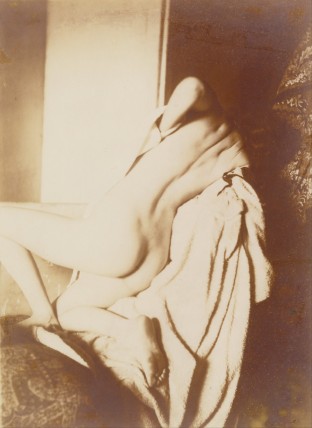
Edgar Degas
Staying Neutral
March 7, 2014 § 3 Comments
Experience teaches us that limitation is the essence of creativity. Like a single flute playing in an echo chamber, the sounded notes of a few colors, a few shapes or lines set up visual resonances within the bounding space of the rectangle, multiplying complexity in unforeseen ways through their endless permutations. Using color in a limited way is a great way to explore this phenomenon. Here are some examples of works that choose to proscribe the range of color intensity, exploring the neutral zone that lies in the center of the color circle. Because of the relativity of color, the rainbow continues to assert itself but in a lowered intensity key. Color appears, not through pigmentation, but through optical relationships. Absence becomes presence.
Jeffrey Reed
October 16, 2011 § Leave a comment
While angry, politicized axe-grinding, and issue-laden work dominates the news of the contemporary art scene, Philadelphia painter Jeffrey Reed is one who has always kept his head down, making modestly scaled paintings from his immediate surroundings. In this video, which showcases the recent work he has done in Ireland at the Ballinglen Arts Foundation and in his home in Philadelphia, Reed shares some of his thoughts about his process and about the meaning of being a painter today.
“…with these paintings, as small as they are, one might be surprised, in that most of the painting, probably 80%.. I do with a brush that’s one, one-and-a-half-inches – Flats – very much in the mode of Hawthorne, laying in blocks of color, blocks of tone, and then pulling it into focus with smaller brushes later. But I paint from those big relationships..
I’m not locked into a certain palette. I usually set up in front of a subject and ask myself how many colors can I get away with, meaning how few colors can I use to capture what’s in front of me. I feel like that bracketing helps me have a more cohesive painting and sense of light…
For me painting is a way of connecting to the world around me and I hope that’s also the experience a viewer might have, that they can have something evoked or triggered in them when they look at a painting, something they can identify with. I struggled with this, as I think most artists would..when I was a senior in college. I was starting to feel as if painting was very selfish; that I was doing it just for me, to get recognition or somebody to acknowledge I had talent. I’ve come to realize that it’s not that. Certainly I’d like to be accepted for what I do but it’s really to make a connection, whether it’s with the landscape around me, the world around me, like the world around Vuillard with him painting his mother, his sister; or it’s through the interaction that someone might have looking at my painting.”
Self-Portraits
March 28, 2011 § 5 Comments
Few subjects in art rival the human face and figure for psychological impact and technical difficulty. Our first clear vision in this world is that of our own mother’s face. Thereafter, the human face holds encoded meanings that become a life’s study.
In painting our own, or others’ likeness the fundamental challenge is learning to see and simplify the major and minor color shapes that the head presents to our eyes, instead of just the details of eyelashes, nostrils and lips. We may wish, in painting the head, to reveal the inner being of our sitter, but that will never happen without careful attention to the outer form. The inner and the outer are inseparable. Charles Hawthorne, the celebrated teacher of Edwin Dickinson and Hans Hoffman, relates a story about painting the portrait of a bald man, becoming fascinated by the colors he observed in the man’s head, one color spot against another, and finding later that he had accurately captured the sitter’s likeness with hardly a conscious thought as to how he was doing that. Seeing is a kind of knowledge.
Following is a gallery of artists’ self-portraits in a loosely chronological order from Rembrandt’s early self-portraits to the work of some notable contemporary painters. Every generation of artists, it seems, is similarly compelled to make its own statement of identity.
In his 63 years on earth, Rembrandt Harmenszoon Van Rijn (1606-1669) painted 88 self-portraits. He first painted himself in his twenties. They are masterful, proud, and just a bit cocky – the new kid on the block hanging out his shingle as a portrait painter. Caravaggio had already come and gone, alerting Rembrandt’s generation to the splendors and mysteries of raking light.
Rembrandt continued to use himself as a model throughout his life documenting his aging face through prosperous times and through the financial setback that beset him late in life. The body of self-portraits that he left us are a great legacy to the world. They have much to teach the aspiring painter about how light and shadow activate an image, how it sculpts the planes of the head and sets up a dialogue between form and space. Rembrandt’s self-portraits also teach us that content or meaning is not something that the painter needs to consciously program or add on. The inner state of the sitter and the outer forms are intimately involved in each other. Only the honest, attentive gaze will reveal it.
- Sofanisba Anguissola, 1532-1625
- Velazquez
- Rembrandt
- Elisabeth Vigee`-Lebrun, 1745-1852
- Joshua Reynolds
- Chardin
- Goya
- Courbet
- Degas
- Degas
- Cezanne
- Gauguin
- Matisse
- Picasso
- Marie Louise Motesiczky
- Vuillard
- Vuillard
- Vuillard
- Beckmann
- Lovis Corinth
- Lovis Corinth
- William Orpen
- Hopper
- Edwin Dickinson
- Edwin Dickinson
- Fairfield Porter
- Louisa Matthiasdottir
- Stanley Spencer
- Alfred Leslie
- Lucien Freud
- Avigdor Arikha
- Catherine Kehoe
- Catherine Kehoe
- David Campbell
- Daniel Dempsey
- Frank Hobbs
